#queue can do it
Text

That means you can survive so many more 💖
#positivity#positive thinking#positive thoughts#positive#positivethinking#positivelypastelpink#positivevibes#positive vibes#pink#pink positivity#pink positivity blog#pink post#pink posts#you have survived every bad day so far#bad day#bad days#keep going#queue can do it
437 notes
·
View notes
Photo

been thinking if they’d be friends
#keigan ann and mary friend trio mayhaps#taking matters into their own hands and becoming the judge#gotta think about it more but bar that i think they'd enjoy the others company#queue can do it
47 notes
·
View notes
Text
does anyone need me to tag rhea the white woman of all time
#talk#cant do shit on twt but i understand if shes a squick so leave an anon pipe bomb in my ask box or smth#not counting likes as yes btw#will boost later#queue can do it
2 notes
·
View notes
Text
Things to Do that Aren't Related to Growing Plants
This is my second post in a series I’ll be making on how to increase biodiversity on a budget! I’m not an expert--just an enthusiast--but I hope something you find here helps!
Some of us just don’t have much luck when it comes to growing plants. Some of us simply want to aim for other ways to help that don’t involve putting on gardening gloves. Maybe you've already got a garden, but you want to do more. No problem! There’s a couple of options you can look into that’ll help attract wildlife in your area without even having to bring out any shovels!
Provide a Water Source
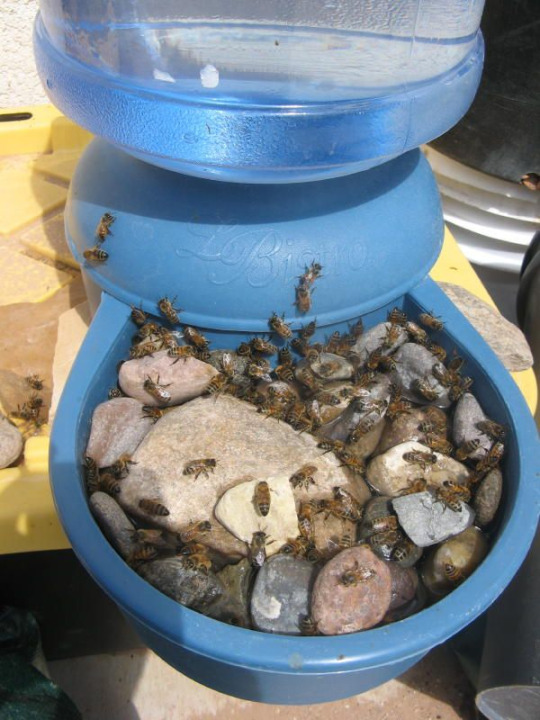
Oftentimes when I see ‘add a water source’ in informational articles about improving your backyard for wildlife, it’s almost always followed by an image of a gorgeous backyard pond with a waterfall and rock lining that looks expensive to set up, difficult to maintain, and overall just… not feasible for me. Arguably, not feasible for a lot of people. And that’s okay! There’s still ways to add water in your garden for all kinds of creatures to enjoy!
There’s tons of ways to create watering stations for insects like bees and butterflies. A self refilling dog bowl can work wonders! Add some stones into the receiving tray for insects to land on or use to climb out, and you’ve got a wonderful drinking spot for all kinds of insects! You can also fill a saucer or other dish with small stones and fill it, though it’ll likely need refilling daily or even several times a day during hot times.
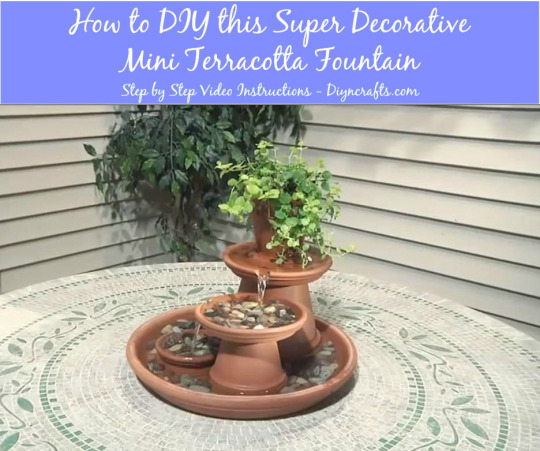
I've seen people online use all kinds of things to make water features. Some go with terra-cotta pots, pebbles, and a cheap pump to get a small and simple fountain. Others use old tires, clay, and a hole in the ground to create an in-ground mini pond system. If all else fails, even a bucket or watertight box with a few plants in it can do the trick--though do be wary of mosquitoes if the water isn’t moving. In situations like these, a solar-powered fountain pump or bubbler are great for keeping the water moving while still making it a drinking option for wildlife (it not even more appealing for some)--and these items can be obtained fairly cheap online!
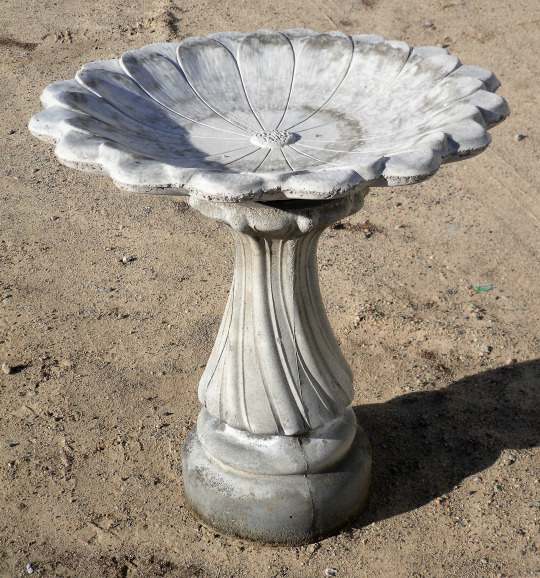
Bird baths are an option as well--a classic way to provide for birds in your area, they can be easy to find online or in a gardening store! The only downside is that a good, quality bird bath can be pricey up-front. However, a nice stone bird bath should last a long time, be easy to clean and refill, and be enjoyed by many birds! I’ve also seen tutorials on how to make your own with quickcrete! Bird baths will be a welcome sight to birds, as they provide a space for them to drink and bathe to regulate the oils in their feathers for flight and insulation. Putting a stone in the middle will also help insects to escape if they fall in, and provide a place to perch so they can get their own drink. You’ll want to change the water and clean the baths regularly--as often as once a week, if you can manage it.
If possible, it’s highly encouraged to fill and refill water features with rainwater instead of tap water. Tap water is often treated, so instead of using hoses or indoor kitchen water, collecting some rainwater is a great alternative. Collecting rainwater can be as simple as leaving cups, bins, or pots outside for awhile.
Butterflies and other creatures will also drink from mud puddles. If you can maintain an area of damp soil mixed with a small amount of salt or wood ash, this can be fantastic for them! Some plants also excel at storing water within their leaves and flowers (bromeliads come to mind), making them an excellent habitat for amphibians as well as a drinking spot for insects and birds.
Bird Feeders and Bird Houses

Some of the fancy, decorated bird feeders are expensive, but others can be pretty low-cost--I got my bird feeder from Lowe’s for around 10 dollars, and a big bag of birdseed was around another 10 dollars and has lasted several refills! If you don’t mind occasionally buying more birdseed, a single birdfeeder can do a lot to attract and support local birds! If you’re handy, have some spare wood, and have or can borrow some tools, you may even be able to find instructions online to make your own feeder. You may not even need wood to do so! Even hummingbird feeders, I’ve found, are quick to attract them, as long as you keep them stocked up on fresh sugar water in the spring and summer!
An important note with bird feeders is that you have to make sure you can clean them regularly. Otherwise, they may become a vector for disease, and we want to avoid causing harm whenever possible. Also keep an ear out and track if there’s known outbreaks of bird diseases in your area. If local birding societies and scientists are advising you take your birdfeeders down for awhile, by all means, do it!

Bird houses are naturally paired with bird feeders as biodiversity promoters for backyard spaces, and it makes sense. Having bird houses suited to birds in your area promotes them to breed, raise their young, disperse seeds, and generally engage in your surrounding environment. Setting them up takes careful selection or construction, preparation, and some patience, but sooner or later you might get some little homemakers! Keep in mind, you will need to clean your birdhouses at least once a year (if not once per brood) to make sure they’re ready and safe for birds year after year--you wouldn’t want to promote disease and parasites, after all. But they could be a valuable option for your landscape, whether you purchase one or construct your own!
Again, do make sure you're putting up the right kind of boxes for the right kinds of birds. Bluebird boxes are some I see sold most commonly, but in my area I believe they're not even all that common--a nesting box for cardinals or chickadees would be far more likely to see success here! And some birds don't even nest in boxes--robins and some other birds are more likely to use a nesting shelf, instead! Research what birds live in your area, take note of any you see around already, and pick a few target species to make homes for!
Solitary Bee Houses

A bee house or bee hotel is a fantastic way to support the solitary bees in your area! For a few dollars and some annual cleaning, you can buy a solitary bee house from most big box nurseries. Alternatively, you can make one at home, with an array of materials you may already have lying around! You can even make them so that they’ll benefit all kinds of insects, and not necessarily just bees.
Though you don’t even necessarily have to break out the hammer and nails, buy a ton of bricks, or borrow a staple gun. Making homes for tunneling bees can be as simple as drilling holes in a log and erecting it, or drilling holes in stumps and dead trees on your property. You might even attract some woodpeckers by doing this!
Providing Nesting Area
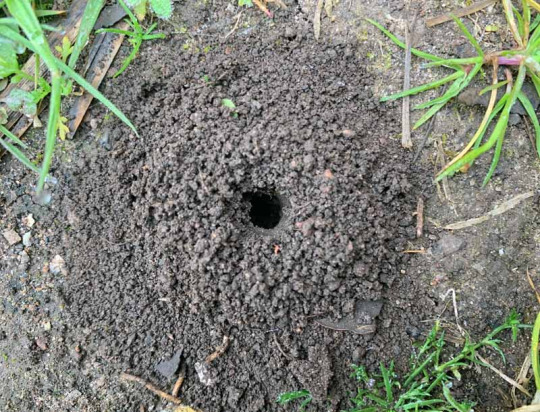
There are tons of different kinds of bees, and they all make different kinds of homes for themselves. Not all of them make big cavity hives like honey bees, or will utilize a solitary bee house. Bumblebees live in social hives underground, particularly in abandoned holes made by rodents--some others nest in abandoned bird nests, or cavities like hollow logs, spaces between rocks, compost piles, or unoccupied birdhouses. Borer, Ground, and Miner bees dig into bare, dry soil to create their nests. Sparsely-vegetated patches of soil in well-drained areas are great places to find them making their nests, so providing a similar habitat somewhere in the garden can encourage them to come! I do talk later in this document about mulching bare soil in a garden--however, leaving soil in sunny areas and south-facing slopes bare provides optimal ground nesting habitat. Some species prefer to nest at the base of plants, or loose sandy soil, or smooth-packed and flat bare ground. They’ve also been known to take advantage of soil piles, knocked over tree roots, wheel ruts in farm roads, baseball diamonds and golf course sand traps. You can create nesting ground by digging ditches or creating nesting mounds in well-drained, open, sunny areas with sandy or silty soil. However, artificially constructed ground nests may only have limited success.
Providing Alternative Pollinator Foods
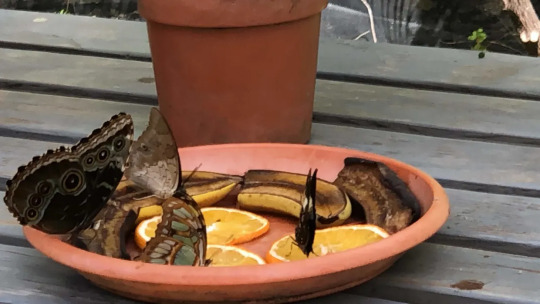
Nectar and pollen aren’t the only foods sought out by some pollinators! Some species of butterflies are known to flock to overripe fruit or honey water, so setting these out can be an excellent way to provide food to wildlife. You may want to be cautious about how you set these out, otherwise it can help other wildlife, like ants or raccoons. Butterflies may also drop by to visit a sponge in a dish of lightly salted water.
Bat Houses and Boxes
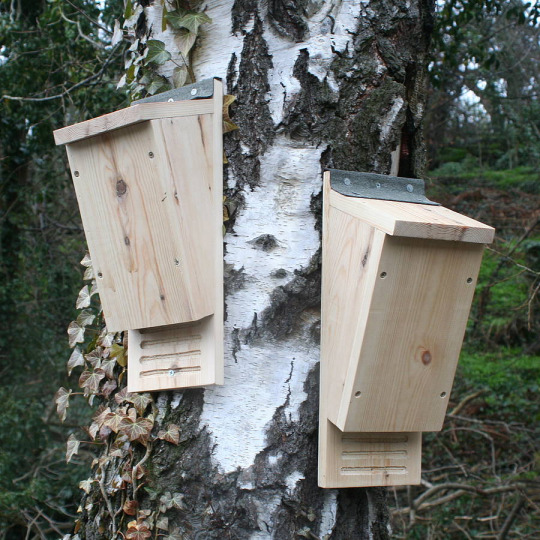
Big or small, whether they support five bats or five hundred, making bat boxes and supporting local bats is a great way to boost biodiversity! Not only will they eat mosquitoes and other pest species, but you may also be able to use the guano (bat droppings) as fertilizer! Do be careful if you choose to do that though--I’ve never had the opportunity to, so do some research into how strong it is and use it accordingly.
Provide Passageway Points
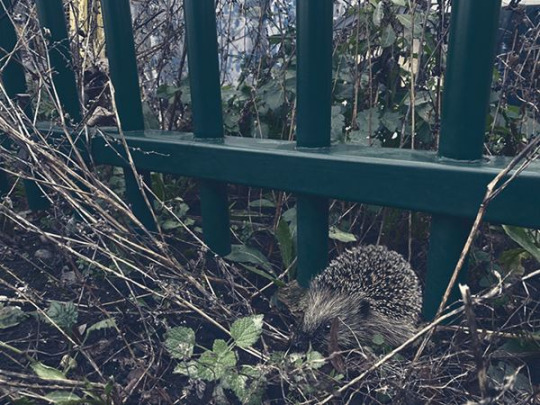
If you want your area to be more accessible for creatures that can’t fly or climb fences, allowing or creating access points can be an excellent way to give them a way in and out. Holes in the bottom of walls or fences can be sheltered with plants to allow animals through.
In a somewhat similar manner, if you’re adding a water fixture, it’s important to provide animals a way to get into and out of the pond--no way in, and they can’t use the water. No way out, and they may drown. Creating a naturalistic ramp out of wood beams or sticks, or stepped platforms out of bricks, stones, or logs can do the trick.
Get or Keep Logs and Brush Piles

I’ve already mentioned logs a good handful of times so far in this post. To be used as access ramps, or as nesting areas for solitary bees. But they have value as much more than that! Logs on the ground provide shelter for all kinds of animals, especially depending on size--anything from mice, reptiles, and amphibians to things like turkey vultures and bears will use fallen logs as shelter. Inside of a decaying log, there’s a lot of humidity, so amphibians are big fans of them--meanwhile, the upper sides of them can be used as sunning platforms by things like lizards. Other animals can also use the insides of logs as nest sites and hiding places from predators too big to fit inside. Fungi, spiders, beetles, termites, ants, grubs, worms, snails, slugs, and likely much more can be found inside rotting logs, using the rotting wood as food sources or nesting places. They can then provide food for mammals, amphibians, reptiles, and birds. They can also be regarded as a landmark or territory marker as wildlife get more familiar with your space.
So how do you get logs for cheap? Try Chip Drop! I talk about them more in a future post, but you can mark saying that you’d like logs in your drop, so they’ll give you any they have! In fact, you may even get a drop faster if you're willing to accept some logs. You may also be able to approach arborists you see working in your area and ask for logs. There may also be local online listings for people selling logs for cheap, or just trying to get rid of them. If there’s land development going on near you, you may be able to snag logs from trees they cut down to make space. Do keep in mind, you don’t need to have huge gigantic logs laying around your property to make an impact--even small logs can help a lot.

If possible, creating and leaving brush piles on the edge of your property can be a great boost to biodiversity--even if you may not see the wildlife using it. They’ll provide shelter from weather and predators, and lower portions are cool and shady for creatures to avoid the hot sun. The upper layers can be used as perch sites and nest sites for song birds, while lower layers are resting sites for amphibians and reptiles, and escape sites for many mammals. As the material decays, they also attract insects, and as such they’ll attract insect-eating animals too. As more small animals find refuse in your brush pile, their predators will be attracted to them as well. Owls, hawks, foxes, and coyotes are known to visit brush piles to hunt. Making a brush pile can be as simple as piling branches and leaves into a mound, as big or as small as you want. You can even use tree stumps or old fence posts near the base, and keep stacking on plant trimmings and fallen branches. Do note that you don’t want to do this near anything like a fire pit.
Don't forget, with all of these, your mileage may vary for any variation of reasons, so don't worry if you can't take all of even any of these actions! Even just talking about them with other people may inspire someone else to put out a bat box, or leave a few logs out for wildlife!
That's the end of this post! My next post is gonna be about ways to get seeds and plants as cheaply as possible. For now, I hope this advice helps! Feel free to reply with any questions, success stories, or anything you think I may have forgotten to add in!
#biodiversity#solarpunk#environmental stewardship#gardening#outdoor gardening#(i know this is literally the Dont Gotta Garden post but these could also be excellent additions to a preexisting garden so)#ani rambles#out of queue#the biodiversity saga#here in the tags to once again emphasize your mileage may vary with all of these#my mom is scared of bats theres no way in hell shes gonna let me put up a bat box#but I have been able to put out a shallow bird bath and a little solarpowered hummingbird bath fountain#do what you can! every bit counts! You may be able to do something that I or your neighbors can't!#for example my nextdoor neighbors have literally no trees in their backyard where the hell would they put a bat box#meanwhile i have trees in my backyard but still can't put up a bat box. maybe the neighbors next to me could!#similarly brush piles are a no go for my family but someone somewhere else could set one up!#i am rambling in the tags now uh long story short do what you can don't stress about what you can't
4K notes
·
View notes
Text
Since there are Archives doppelgangers in the Protocol world, that means there were probably Protocol doppelgangers in the Archives world as well.
I want Colin to have been the IT guy at the Magnus Institute who had to deal with all of Not!Sasha's verification errors in S2.
#the magnus protocol#8 running on empty#tmagp spoilers#my magnus protocol stuff#original post#colin becher#not!sasha#...i do not remember what episode that was if someone else can please drop a comment and ill tag it#queue cause i'll be at work when the episode airs#500 notes!
892 notes
·
View notes
Text
Some sketches. Still trying to get comfortable drawing these dorks


#supernatural#spn#spn fanart#deancas#destiel fanart#destiel#dean winchester#sam winchester#crowley#crowley supernatural#queue changed me#a girl can try#oh joy another show to be emotionally devastated over#i watched for the autistic angel#and then was given the saddest wnding to a character ive ever seen in my life#why would they do this to me
1K notes
·
View notes
Text
NO LONGER ACCEPTING REQUESTS as it is past the 28th!!
thank you to everyone who donated, and I’ll complete the requests that are currently pending but will not be taking any more.
hi! to help encourage donations, i’m offering drawings to anyone who donates or sends an e-sim to gaza. here is a tutorial on how on the gaza e-sims website and here is another one on tumblr. check the notes of this post for discount codes if you’re into that. i will be doing this until the 28th of february!
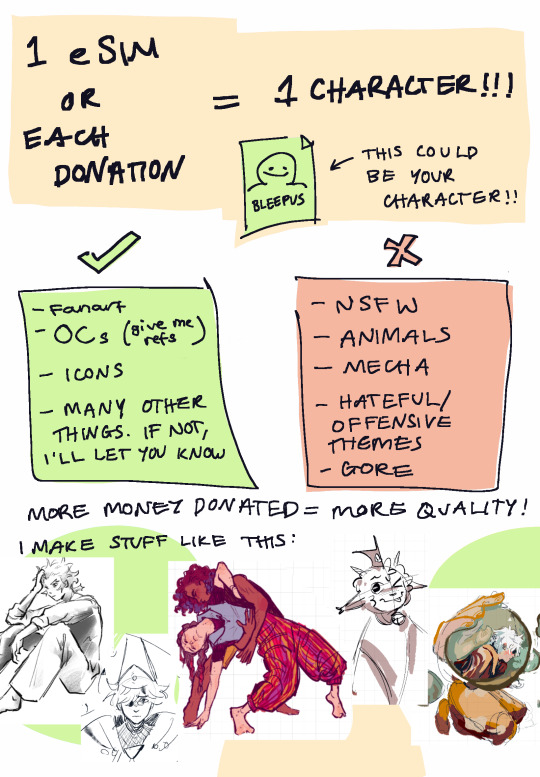
alternatively, you can donate to any one of these instead:
Pious Projects (twitter)
Help Gaza Children (proof of impact)
Care for Gaza (twitter)
Medical Aid for Palestinians (twitter)
Help Ahmed and his family evacuate (his account)
Help Mohamed and his family get medical help and evacuate (post)
Palestine Children's Relief Fund (twitter)
Anera (twitter)
Help a family of 13 evacuate
Urgent support for medical professionals
OR donate to any other legitimate fundraiser!
i am only accepting donations made from 10th feb onwards! send me a screenshot of your receipt with timestamps through DMs or email me at [email protected] (but cover your personal details), along with the character you would like. sending one or two reference images is also highly encouraged!
there’s no lower limit to donations that i’ll draw for! a dollar or two is still money, and every little bit helps. that said, I won’t be spending over 5 hours on any one drawing so that i don’t burn out. im going to try and do as many of these as i can, but if i am uncomfortable with your request i will refuse it (but that almost certainly won’t happen tho)
#crowcraft#i havent done requests in ages so I’m nervous! but I really really want to do what I can#not sure how to tag this properly but:#donations for gaza#Palestine#free palestine#gaza#donation commissions#esims for gaza#esims commissions#commissions open#requests#IM A SMALL BLOG PLS REBLOG THIS IF U WANNA. IT HELPS#I’ll queue this to reblog itself through the night so the americans see it. ok im going to bed#OH FANDOM TAGS FOR THE ART HERE. OOPS#cotl#cult of the lamb#wha#witch hat atelier#ocs#lmk#lego monkie kid
733 notes
·
View notes
Text
AdaCol2, pointing at a B-E SecUnit: query?
Murderbot: Yeah that one doesn't have free will.
AdaCol2: ...query?
Murderbot: Sigh. Yeah it has a specialized module in its brain designed to pass commands from a controlling system and enforce them, and it can't disobey-
AdaCol2: query??
Murderbot: -or else the governor module will punish and/or kill it, yeah.
AdaCol2: q u e r y ??¿?
Murderbot, tiredly: Fuck if I know why.
#verso talks#shitpost#i love adacol2 y'all#murderbot diaries#system collapse#system collapse spoilers#Murderbot#preservation humans aren't the only ones who can do this song and dance lol#queue
956 notes
·
View notes
Text
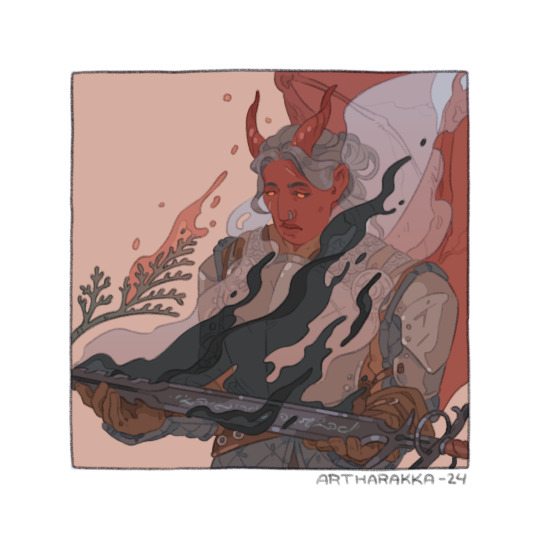
🔥🌿 Commission for @ mle.samson on instagram 🌿🔥
#commission#ttrpg#tiefling#this is one of the last few swordtember commissions I've taken (two more in queue)#but I've been making them bit slower since they were a bit cheaper so I've been only doing them inbetween other commissions#BUt now I added this kind of commission option to my commission info so you can hop onto my regular waitlist and have this delivered to you#otherwise also renewed my offers if you are interested#anyway thanks to to the commissioner 🧡🔥 loved doing this!
367 notes
·
View notes
Text

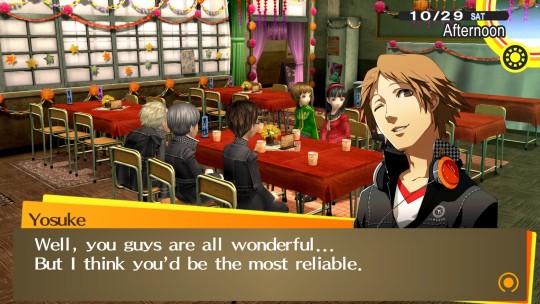

#p4#p4g#persona 4#persona 4 golden#hanamura yosuke#yosuke hanamura#souyo#(vomits blood)#okay honestly is there even anything to say about this#yosuke is so easy to tease because he plays along so easily#but also his favourite quality in a person is reliability huh? cool. good to know.#oh hey do you think about how in the reverse scenario when hes on the boys side#where he said his ideal gf was someone he could protect#and when yu says yosuke is his ideal bf yosukes gets embarrassed but is like oh well im not too bad looking! and im pretty reliable!#hahaa wow its almost as if yu and yosuke both want someone that they can rely on and someone that would rely on them in turn#if only they both had someone like that. someone they could both trust beyond measure. someone thats an equal. a partner#also shout out to tumblr user aibyoutachi for convincing me that i should play the other side with yosuke sitting with the girls#because ive always sat in the girls seat not realising that sitting in the boys seat meant yosuke would take your place#oh wait that means theyre the only two that are different hahaha PARALLELS OR WHAT#he's good with his queue
742 notes
·
View notes
Text
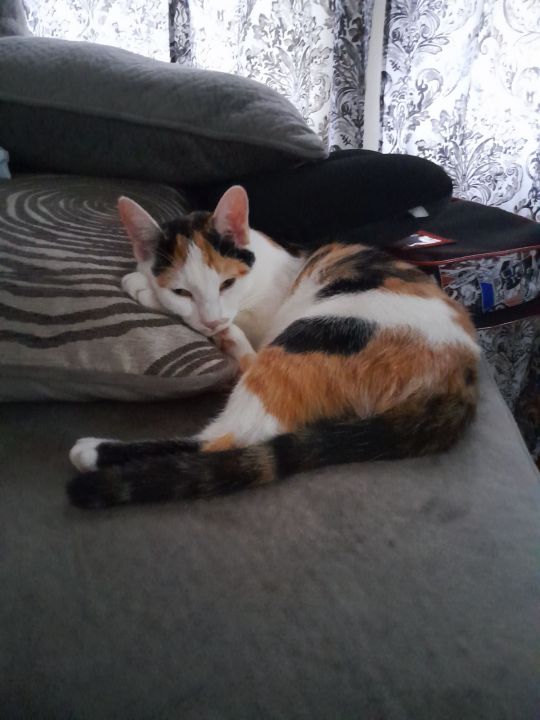
I dont have a clever and witty sarcastic comment tonight, I just think she's cute
#my brain isnt working rn its 3am ive been reading fanfics while hyperventilating over the irreparable damage i managed with my limited life#tee hee im just kinda feeling moody tonight 🤪#somebody please ban me from tumblr between 1am to 11am i do not function as a stable person between those times#i schedule my mental breakdowns they work really well with my schedule#its multitasking cause I'll already be up from insomnia its really efficient in the grand scheme of things#ah i love the fact that nobody can stop me from writing the most deranged shit in the tags of a cute cat pic <3#animals#petblr#cat#cat life#cat lovers#catblr#my cat#cat photos#cat pictures#cats of tumblr#calico#calico cat#OH UH THATS WHAT I WAS SUPPOSED TO SAY FOR AMERICANS THE REASON IM SAYING ITS NIGHT WHEN THIS IS POSTED DURING THE DAY IS BECAUSE ITS QUEUED#i queue most stuff because i dont usually have the energy or time to be active at good times#i get little bursts of post motivation and dont wanna flood my 9 followers (at least 6 are dirty bots) with my bs#im just a dumbass that never tags shit
586 notes
·
View notes
Text
I don’t think my partners understand how in the palm of their hand I am. All they have to do is say my name a certain way, call me pup/puppy, praise me or flirt with me and my cock is twitching and I’m clenching around nothing. Irl it would be worse. I’d let them do whatever they wanted to me as long as they called me good boy and held me, wanna slide inside to breed me? Hold my chin in your hand as you pull my pants down. Want head? Press your fingers against my lips and let me suck on them while calling me good boy or mutt before you take your underwear off. Need something to rut against? Call me over and pat where you want me, tell me to pull my skirt and boxers off so you can rub against my tdick. Need to take your frustrations out? Call me good mutt while you breed my pussy or facefuck me. Get jealous? Call me your pretty boy while you fuck me for as long as you want. I’d get on my hands and knees for these two in an instant no hesitation. I am foaming at the mouth I need them to breed me PLEASEEEE-

#pills timer (queue)#pills for my beloved#🦎Gecko#🌅Haven#I’m deadass about to tell them when they visit they can do whatever with me#im FERAL#only thing stopping me is my anxiety FUCK#poly nsft#agender nsft#trans nsft#bd/sm switch#nsft trans#‘nsft’#mlm nsft#mlm ns/fw#t4t bd/sm#nblm nsft
482 notes
·
View notes
Text
claude von riegan after realising he's begun to sympathise with a woman who over 1000+ years never bothered to think up a doctrine to protect her family that didn't rely on suppressing the human race

#claude von riegan#talk#fe3h#fe three houses#fe16#sorry#queue can do it#*[suppressing] them for a good (non-zero) number of those 1000+ years
9 notes
·
View notes
Text
Un-Actions, or Restriction of Activities
This is my first post in a series I’ll be making on how to increase biodiversity on a budget! I’m not an expert--just an enthusiast--but I hope something you find here helps!
There’s a good handful of ways you can help increase biodiversity in your yard that don’t require buying things--in fact, these may actually help you save money in the long run! They may seem small and simple, but every bit counts! Whether you can do these in totality, or just limit how often you do these actions, it’ll make a difference.
Not Mowing, or Mowing Less Often

Turf grass lawns are considered a monoculture, meaning they don’t provide much opportunity for insects to find habitat--so few other creatures find them enjoyable either. An expanse of turf grass is, in many ways, a barren wasteland in the eyes of wildlife--too exposed to cross, with few to no opportunities for food or shelter, leaving them exposed to blazing hot sun, freezing cold, or any predators that may be lurking nearby. A place to be avoided. The simple act of letting your grass grow unbothered gives a chance for wildflowers to grow, and for your grass to grow taller--providing more habitat for insects, which then provides more habitat to birds and other creatures that feed on said insects. Wildlife want nothing more than to skirt by unnoticed, so even leaving the grass tall along the edges of a fence or yard can help a little. Even restricting mowing to every other week, or at a higher blade setting, can be a huge help. If HOAs or city ordinances are fussy about lawn length in the front yard, you can likely still keep grass higher in the backyard. Or, you can create a ‘feature’ where grass is allowed to grow long in a specific area. If it looks purposeful, people are more likely to accept it. Not mowing under trees or close to shrubs not only leaves space for wildflowers to grow, but also means you don’t have to deal with mowing over bumpy roots and other difficulties. Cutting different areas at different times can be an option for letting grass grow long in some areas while still having available places for play and entertainment. I’ve seen some people plant flower bulbs when pulling up weeds, so in the future they'll bloom in early spring before mowing is usually necessary. This could be another fun way of adding biodiversity to a lawn without--or before you--begin mowing in spring.
Not worrying about mowing, or doing it less often, saves you in time, money, and energy. You won’t have to buy as much gasoline for your mower, and Saturday afternoons can be free to be enjoyed in other ways aside from being sticky and sweaty and covered in grass stains. In addition, you’ll likely be lowering your own carbon emissions!
If you do have to mow your lawn, I’ve got ways you can use your grass clippings to boost biodiversity later in the post series!
Not using pesticides, herbicides, fungicides, etc.
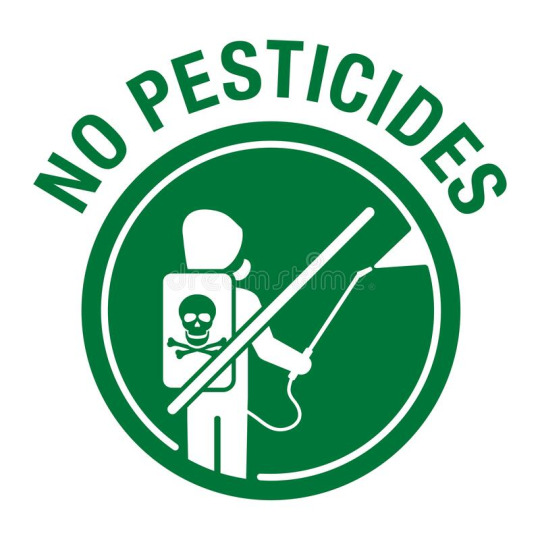
One of the next-biggest non-actions you can do asides from not mowing is using fewer fewer to no herbicides, fungicides, and pesticides in your yard. This’ll easily allow for more biodiversity. Allowing more insects and a wide array of plants to thrive will feed back into the entire food chain in your area. In addition, these types of chemicals have been tied to algae blooms, death of beneficial insects, harm to birds, fish, and even humans. Soil is supposed to be full of fungi, especially fungal mycelium that essentially acts as a network for plants to communicate, share nutrients, and support each other--fungicide kills that, and typically makes all other lawn problems even worse in a negative feedback loop. It may take awhile to see the benefits of avoiding these chemicals, but once you see it, it really is astounding.
However! I can’t lie and say that there haven’t been points where I needed to use pesticides at some points in my gardening journey. In these cases, try to use products that are organic--like diatomaceous earth, neem oil, etc--and use them accurately, correctly, and sparingly. Follow instructions on how to apply them safely and responsibly--for example, on non-windy days and during times when bees and other pollinators aren’t likely to be out and about. With some pests (read: oleander aphids, in my experience), a simple jetstream of water is enough to force them off the plant where they’ll be too weak to get back. Eventually, you should have a balanced enough ecosystem that no one insect pest causes a major issue with the work you’re doing to boost biodiversity.
If you can bear to, try handling pests manually. Squishing pest bugs in your hand is a pretty foolproof way to get rid of some problems, or spraying them with a mix of soap and water can do the trick on some insects. Alternatively, picking them off your plants and into a bucket of soapy water is also a valid option. You’ve heard of baptism by fire, now get ready for… baptism by soap?
But also! Try reconsidering what you consider a pest! Tomato hornworms are hated by gardeners, for devouring the foliage of beloved tomato, pepper, and potato plants. But killing the tomato and tobacco hornworm means getting rid of sphinx moths, also known as hummingbird or hawk moths! Hawk moths are vital to the survival of many native plants, and are sometimes even the only species that pollinates them. If you can bear to, consider sacrificing a few tomato plants, or growing a few extras, so we can continue having these beautiful moths for years to come. After all, they may not even do significant damage to the plants!

With that in mind, be friendly to your natural pest managers! Lacewings, ladybugs, praying mantises, wasps, birds, bats, and more will help manage pest populations in your environment! Encourage them by planting things they like, providing habitat, and leaving them be to do their work! Avoiding pesticides helps make your garden a livable environment for them, too!
Letting Weeds Grow
Many of the plants we know as 'weeds' are actually secondary succession species and native wildflowers. Milkweed was regarded as a noxious, annoying weed for a long time, and now people are actively trying to plant them after learning about the important role they play in our environments! Weeds are adapted to take over areas that have been cleared out of other plants after a disaster, so they're doing much of the initial work in making a habitat for other creatures. In fact, many of them will simply die back as the environment repairs itself.
An important thing to note is to please make sure that your ‘weeds’ are not invasive species. Work on learning how to identify native and invasive species in your area, and pull out what’s harmful to leave room for what’s good!
Don’t Rake (Or At Least Don’t Bag Your Leaves)

Many insects overwinter in piles of leaves that we often rake away and bag up in the fall and winter. By doing this, we are actively throwing away the biodiversity of our neighborhoods! If you can, leave the leaves where they fall!
If you do need to rake, put the leaves in places wildlife can still access it instead of bagging it up. Move your leaves into garden beds to serve as mulch, or along the edge of fences to rest while keeping egg cases and hiding bugs intact and free to release come spring.
Leave Snags Where They Are
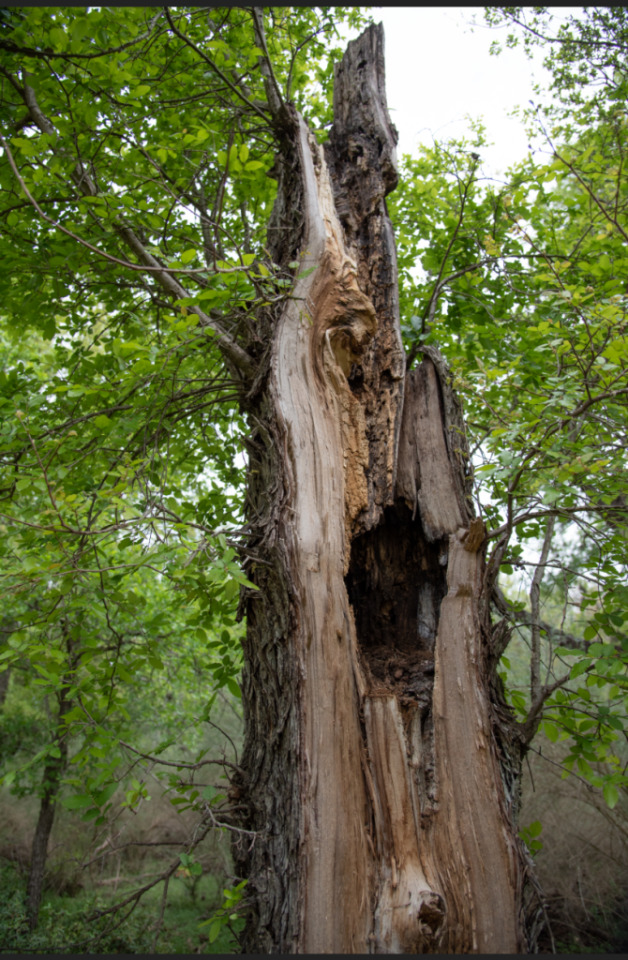
Snags are dead trees/dead branches on living trees. They provide an important wildlife habitat--many birds nest in them, or use them to seek cover from rain, and many insects will also live in snags (making them an additional food source for birds and other creatures). Tree cavities are used as nests by hundreds of bird species in the US, and many mammals use them as well, such as bats, squirrels, raccoons, and sometimes even bears. Some trees form cavities while they’re still alive, but in conifers they’re more likely to form after death. Crevices between the trunk of a dead tree and its peeling bark provide sun protection for bats and amphibians, and leafless branches make great perching areas for birds of prey to hunt from above. The decaying wood is home to insects and fungi, who then feed birds, mammals, amphibians, and reptiles. Do check on the snags regularly to ensure they don’t serve a threat to any nearby structures, but whenever possible, leave them be!
Keep Your Cat Inside
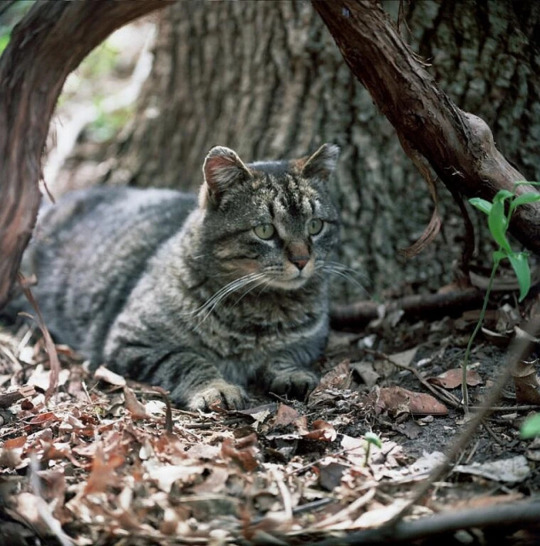
If you have an outdoor cat, consider making the adjustments to have it be an indoor cat. If you have an indoor cat, keep it as an indoor cat. Free ranging cats impact biodiversity through predation, fear effects, competition for resources, disease, and more. Keeping little Mittens inside does a lot more to help than it may seem from the outside.
That’s the end of this post! My next one’s gonna be on things you can add to your space that aren’t directly related to growing plants. For now, I hope this advice helps! Feel free to reply with any questions, success stories, or anything you think I may have forgotten to add in!
#biodiversity#solarpunk#gardening#outdoor gardening#lawn culture#anti lawn culture#environmental stewardship#(i think that counts)#ani rambles#out of queue#the biodiversity saga#I know I said this in the masterpost already but another reminder some people aren't in a position to do all or some or even any of this#i have so far been unsuccessful in convincing my parents to not mow or rake because we live in an HOA neighborhood#but do what you can/are able to! it'll help!
1K notes
·
View notes
Note
Gaster but he says “oya oya”. Trust me on this.


is this it. is this what you wanted from me.
#queueing this if i don’t post by january#anyway is this what you wanted anon. do you feel seen. was it worth it.#and i’m asking whyyyyy looooord (musical riff+sfx)#… is my exhaustion obvious or is this a shitpost. the answer is yes#i really don’t have an explanation for this#does gaster know this is an anime meme bc of alphys or is he totally in the dark#which one is funnier#utdr#utdr fanart#deltarune#deltarune fanart#wd gaster#gaster fanart#ney’s art#ney’s comics#tagging just for blog navigation but also burying tags below what will show up in searches so it doesn’t break containment#… can asks even show up in searches#i actually don’t know#but hey whatev#ney’s chatter (ask answers)#it’s rude to talk about someone who’s listening#shitpost
400 notes
·
View notes
Text










it was literally their moment and they just let us watch
(if you need me i'll be marinating in this for the foreseeable future)
#magneto#rogue#rogneto#rogueneto#IT WAS SO DIFFICULT TO PICK ONLY 10 IMAGES. SOSOSOSO DIFFICULT. EVERYTHING ABOUT THIS SCENE WAS FUCKING SUBLIME.#thank you to the person who pointed out the bg music is ace of base 'happy nation' ;wwwwwww; SUCH A GOOD SONG FOR THIS#okay but for real never have i had a stronger 'GOD I WISH THAT WERE ME' moment#magneto can we all form a queue to dance with you romantically in the air while an audience watches.............#their body language. their HANDS. OLD MAN WHAT ARE YOU DOING WITH YOUR MOUTH AND YOUR TONGUE BY HER NECK#no word of a lie ive probably watched this scene 200 times today. new comfort media. inject it directly into my veins.#my husband laughing at me as i rewind and play over and over again from the other side of the room#my fave fave FAAAAVE part of this animation is the lil pan they do#the one between mags and rogue and the lyric 'where the people understand and dream of perfect man'#THERE IS SOMETHING SO SOFT AND ROMANTIC AND ADORING ABOUT IT#disintegrates like a sopping wet piece of bread. thank you animators who worked on this scene#i feel like i am burning with the excitement of a thousand suns over this#xmen 97#leigh's magneto hours
254 notes
·
View notes